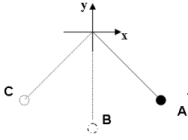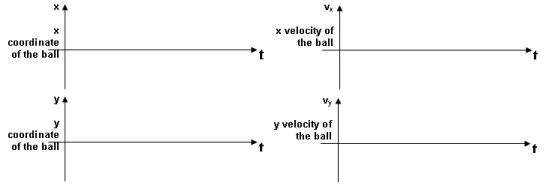
Teaching Physics with the Physics Suite
Home | Action Research Kit| Sample Problems | Resources | Product Information
Problems Sorted by Type | Problems Sorted by Subject | Problems Sorted by Chapter in UP
 |
Teaching Physics with the Physics Suite
Home | Action Research Kit| Sample Problems | Resources | Product Information |
Problems Sorted by Type | Problems Sorted by Subject | Problems Sorted by Chapter in UP |
| A pendulum with a ball at the end is set swinging by holding it at the point marked A in the figure and releasing it. The x and y coordinate are shown with the origin at the crossing point of the axes and the positive directions indicated by the arrowheads. (a) During one swing, the string breaks exactly at the bottom-most point of the swing (the point labeled B in the figure) as the ball is moving from A to B towards C. Using solid lines sketch on the figure the path of the ball after the string has broken and sketch qualitatively the x and y coordinates of the ball and the x and y components of its velocity on the graphs at the right. Take t=0 to be the instant the string breaks. |

|

Not finding what you wanted? Check the Site Map for more information.
Page last modified October 21, 2002: D16